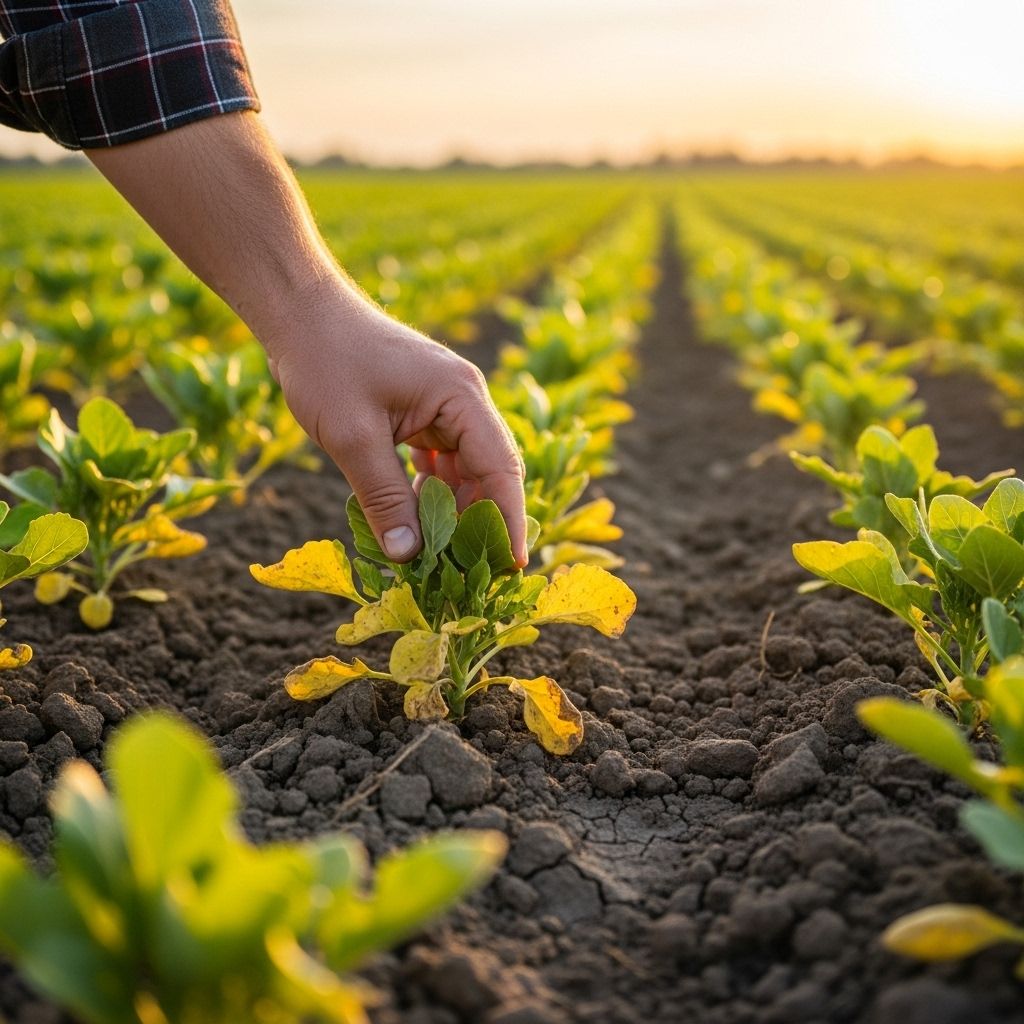Soil Sulfur: 5 Deficiency Signs, Key Roles & Management Tips
Balanced sulfur levels yield deeper blooms, stronger roots, and improved nutrient uptake.

Soil Sulfur: Essential Roles, Deficiency Signs, and Management in Your Garden
Among all the nutrients essential for healthy plant growth, sulfur is often overlooked by gardeners. Yet, it plays a critical role in both soil health and plant vigor. This article explores everything you need to know about soil sulfur: what it does, how it works in your soil, deficiency symptoms, sources and application methods, and practical tips to maintain balanced levels in your garden for continuous, productive growth.
What Is Sulfur and Why Does It Matter for Plant Growth?
Sulfur (S) is a macronutrient necessary for all plants. It is a major component in the formation of vital plant proteins, enzymes, vitamins (like biotin and thiamine), chlorophyll, and is pivotal in the synthesis of some hormones. Without enough sulfur, plants struggle to use nitrogen and produce essential amino acids needed for robust development.
How Does Sulfur Work in the Soil?
Sulfur is found in soil in both organic and inorganic forms. Its effectiveness depends largely on its form and the soil conditions around it:
- Elemental sulfur must be oxidized by soil microbes to become plant-available as sulfate (SO42–).
- Sulfate is the form of sulfur actually absorbed by plant roots.
- The sulfur cycle in soil relies on biological activity, especially the presence of beneficial bacteria to transform sulfur into forms plants can access.
- Soil pH and microbial activity
The reason sulfur acidifies soil is due to reactions that yield sulfate and free hydrogen ions, leading to lower pH values—a vital aspect for many fruit- and flower-producing plants.
The Role of Sulfur in Lowering Soil pH
If your soil is too alkaline (pH above 7.0), many micronutrients become less available to plants. Applying elemental sulfur or sulfur-rich amendments can help by:
- Producing sulfuric acid upon breakdown, which releases hydrogen atoms.
- Gradually lowering the pH over time, making micronutrients more accessible.
- Working best when there is active microbial life in warm, moist conditions.
This is different from applying lime (calcium carbonate), which raises soil pH almost immediately via chemical reactions. Sulfur, however, relies on microbial processes and typically acts more slowly.
Signs and Symptoms of Sulfur Deficiency in Plants
Understanding the deficiency of sulfur is key to maintaining a thriving garden. Here are common signs plants may show when sulfur is in short supply:
- Yellowing of New Leaves: Older leaves typically remain green while new growth turns pale or yellow (chlorosis).
- Stunted Growth: Plants may appear weak, with thin stems and stunted shoots.
- Poor Root Development: Reduced vigor, root mass, and branching.
- Delayed Maturity: Slower development and reduced flowering or fruiting.
- Low Yield: Lower quantity or quality of produce.
Unlike nitrogen deficiency, which affects older leaves first, sulfur deficiency is most apparent on new growth due to sulfur’s limited mobility in the plant.
Sources of Sulfur in the Garden
Sulfur can enter your soil through a combination of natural and supplemental means. The main sources commonly used by gardeners are:
- Elemental sulfur powder, granules, or prills (organic or mineral amendments)
- Sulfate-containing fertilizers: ammonium sulfate, potassium sulfate, magnesium sulfate (Epsom salt)
- Gypsum (calcium sulfate), which also provides calcium
- Compost and manure, especially from animals fed high-protein diets
- Rainwater and atmospheric deposition (minor source in most modern locations)
- Prilled sulfur, tiny pellets that are easy to spread, especially for large applications or commercial gardens
Epsom salt (magnesium sulfate) is a popular choice for its dual role in supplying both magnesium and sulfur. However, avoid over-application if your soil is already sufficient in magnesium.
How to Apply Sulfur in the Garden
Testing Your Soil First
Before any sulfur application, test your soil for both pH and sulfur content. Whether you use a professional laboratory analysis or a reliable home test kit, knowing your baseline makes targeted amendments possible and prevents overuse.
Application Rates and Methods
| Garden Area | Elemental Sulfur Application Rate* | Application Tips |
|---|---|---|
| Berries and Hydrangeas | 5–10 lbs per 50 sq. ft. (depending on target pH) | Mix into soil; water well. Apply in early spring for established plants, and test seasonally. |
| Vegetable Gardens & Beds | 5 lbs per 50 sq. ft. (per point of pH reduction required) | Distribute evenly, incorporate into top soil layer, water in. Test and maintain as needed. |
| Trees, Shrubs & Vines | 1 cup per inch of trunk diameter (established plants) | Spread from trunk towards drip line, cover with soil or mulch, water thoroughly. |
*Actual application rates can vary with specific products. Always follow manufacturer instructions.
When to Apply Sulfur
- Spring and summer are prime times, as microbial activity drives sulfur oxidation under warm, moist conditions.
- Always water after application to aid breakdown and integration.
Effect of Sulfur on Different Plant Types
- Acid-loving plants like blueberries, azaleas, rhododendrons, and hydrangeas often need lower pH and will benefit most from sulfur amendments.
- Fruit and vegetable crops like onions, cabbages, beans, and garlic use significant sulfur for both growth and flavor.
- Hydrangeas’ flower color is directly influenced by soil pH: acidic soils (made possible by sulfur) encourage deep blue hues.
Benefits of Prilled Sulfur
- Easy to spread and measure for both home and commercial gardens.
- Breaks down more slowly for long-term pH management.
- Offers consistent and uniform coverage.
Other Benefits: Disease and Pest Protection
Sulfur offers surprising benefits beyond just nutrition:
- Natural fungicide: Suppresses fungi-caused diseases like powdery mildew on leaves and stems.
- Pest repellent: Sulfur can deter some mites and pests, including certain species of spider mites.
Potential Problems: Sulfur Toxicity and Overuse
Although rare in home gardens, sulfur toxicity can occur if application rates are too high:
- Excess sulfur can increase soil salinity (salt concentrations), leading to poor water uptake or leaf tip burn.
- Plants may exhibit leaf scorch, chlorosis, or overall decline.
- Keep applications within recommended rates and always re-test soil periodically.
Best Practices for Using Sulfur in Your Garden
- Test soil pH and sulfur content before applying amendments.
- Follow recommended application rates for specific plant types and garden uses.
- Incorporate into soil and water in well to facilitate biological breakdown.
- Consider combining with other nutrients (like nitrogen) for improved plant uptake.
- Track changes by retesting soil every 6–12 months, especially after major amendments.
Frequently Asked Questions (FAQs) About Soil Sulfur
Q: Why does sulfur lower soil pH and how fast does it work?
A: Sulfur lowers pH by forming sulfuric acid as it oxidizes—a biological process that takes weeks to months depending on temperature, moisture, and soil activity. It is slower than adding lime or other rapid pH-adjusters.
Q: Is Epsom salt a good sulfur fertilizer?
A: Yes, Epsom salt (magnesium sulfate) provides both magnesium and readily available sulfate sulfur, making it a valuable supplement if your soil needs these nutrients. However, make sure to check for existing magnesium levels before use.
Q: How do I know if I need to add sulfur to my soil?
A: Look for signs of deficiency, such as yellowing new leaves and slowed growth, but always confirm with a soil test—sulfur should only be added if your soil’s test results and plant symptoms suggest a deficiency.
Q: Can I use sulfur on all plants?
A: Sulfur benefits most plants, especially acid-loving species, but not all plants need their soil made more acidic. Some, like many native prairie or Mediterranean plants, prefer neutral to slightly alkaline conditions. Always research your plant’s preferences first.
Q: What happens if I add too much sulfur?
A: Over-applying sulfur can make soils too acidic and increase salt content, leading to poor plant health and possible toxicity symptoms. Always dose carefully and re-test the soil.
Summary Table: Sulfur Sources and Uses
| Source/Product | Form of Sulfur | Best Use |
|---|---|---|
| Elemental Sulfur | S | Lowering soil pH, long-term garden pH management |
| Prilled Sulfur | S (pelletized) | Easy spreading, slow release for sustained results |
| Epsom Salt | Magnesium Sulfate (MgSO4) | Quick nutrient supplementation (sulfur and magnesium) |
| Gypsum | Calcium Sulfate (CaSO4) | Provides calcium and quick-release sulfur; does not affect pH significantly |
| Compost/Manure | Organic S | Gradual sulfur increase along with organic matter enrichment |
Recap: Why Sulfur Is Vital in Your Garden
- Essential nutrient for protein and enzyme synthesis in plants
- Aids in chlorophyll formation and healthy green growth
- Improvements in soil pH for acid-loving plants
- Boosts nutrient uptake, disease resistance, and sometimes pest tolerance
By testing soil, choosing the right sulfur source and following best practices, you can prevent deficiencies and harness sulfur’s many benefits for a lush, productive garden.
References
Read full bio of Anjali Sayee












